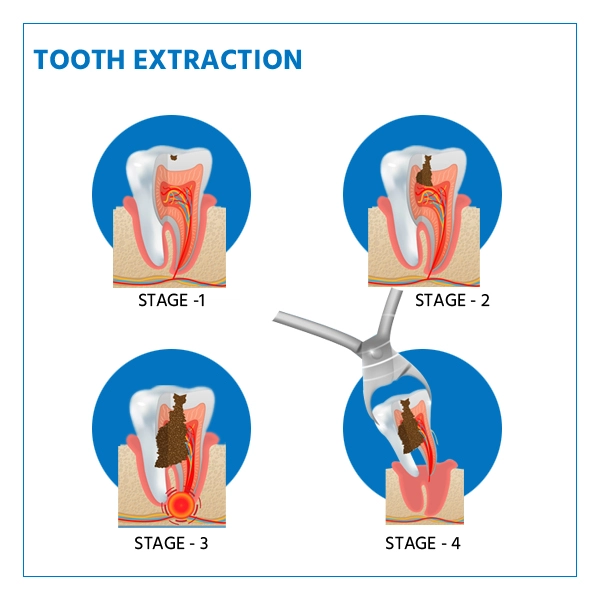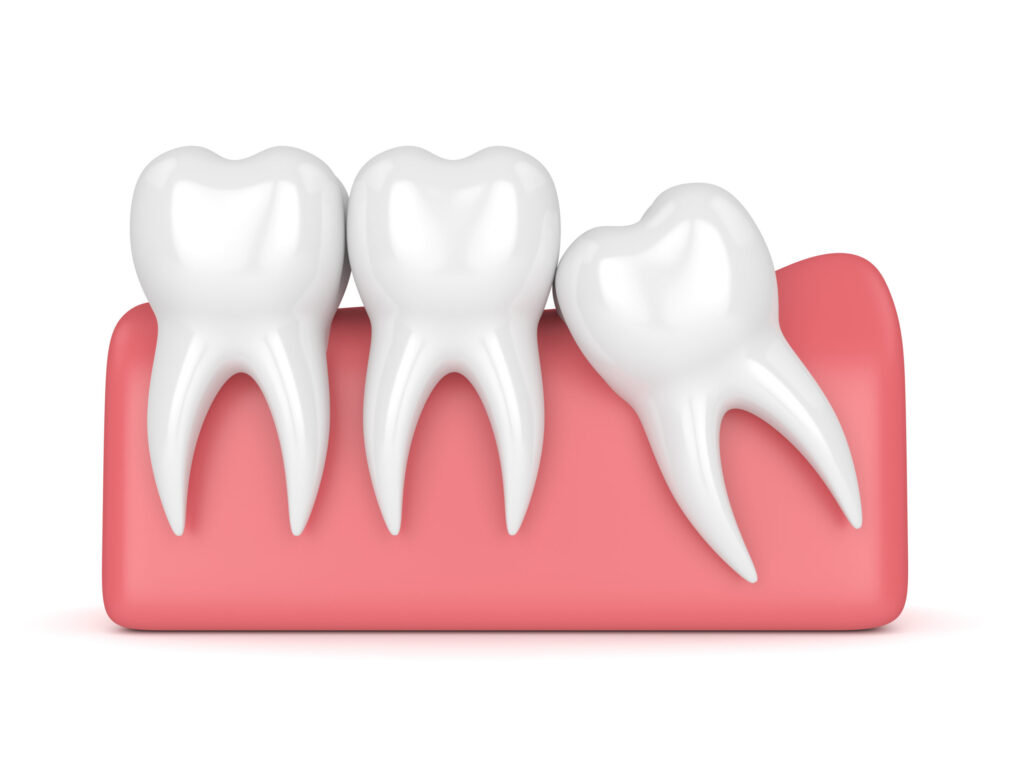
To achieve optimal results with straight teeth and a healthy smile, certain orthodontic cases may require tooth extraction for braces, which involves the removal of teeth.
However, it’s important to note that tooth extraction is only recommended when it is absolutely necessary. Your orthodontist will thoroughly evaluate all options to achieve a healthy smile before considering this procedure.
For individuals with extra teeth or excessive crowding that prevents proper alignment, tooth extraction can be an effective and safe solution. Although some people may feel anxious about the idea of getting teeth extracted for braces, rest assured that under the careful supervision of an experienced orthodontist and the expertise of a qualified dentist or oral surgeon, the extraction process can be comfortable and successful.
This comprehensive guide aims to provide you with essential information about dental extractions before or during braces or Invisalign orthodontic treatment.

Tooth extraction is a procedure in which a dentist removes a damaged, decayed, or infected tooth from the jawbone. The procedure is usually performed under local anesthesia to numb the affected area and minimize discomfort. In some cases, a general anesthesia may be necessary for more complex extractions. There are several reasons why a tooth may need to be extracted, including overcrowding, infection, gum disease, and orthodontic treatment. After the extraction, the dentist may recommend a replacement tooth, such as a dental implant, to restore biting and chewing function and maintain the proper alignment of the remaining teeth.
In some orthodontic situations, tooth extractions may be required to relieve crowding and create a stable bite. These extractions are done either before or during orthodontic treatment.
Extraction is not always essential, in fact, it is rarely required. If it is possible to move all of the patient’s existing teeth into a healthy bite and proper position without extractions, they will do so. However, for some patients, tooth extraction is a viable strategy for getting straight teeth with long-lasting results.
Depending on the specifics of your diagnosis, your orthodontist may recommend that you have one to four teeth extracted. (Extractions of wisdom teeth are not counted as orthodontic extractions because there are other reasons to get rid of these molars). When addressing bite asymmetry or traumatic biting, it’s usual to remove an odd number of teeth.
When deciding which teeth to remove, your orthodontist will think about how best to move the other teeth into their healthy, right places while causing as little change as possible to the mouth, face shape, and tongue position of the patient. Orthodontists can use 3D modelling scans to figure out where extractions will be most helpful.
Which teeth are extracted for braces depends on the patient’s specific case, but generally, the 4th and 5th teeth counting from the front of the mouth, are the most likely to be removed during tooth extraction for orthodontic purposes.
In some situations, a back molar may be taken out instead of or in addition to the premolars.

There are several alternatives to tooth extraction, depending on the specific situation and needs of the patient. Some of the common alternatives include:
Teeth extraction for braces (also known as teeth removal for braces) is a procedure that is not required for all orthodontic cases. It is primarily recommended in specific instances where severe dental crowding is present. It is important to note that not all orthodontic treatments call for teeth extraction, and only a small percentage of cases necessitate this procedure.
The primary purpose of teeth extraction for braces is to create sufficient space in the jaw to achieve optimal results, including straight teeth and a healthy bite. In cases of overcrowding, where there is limited room to accommodate all the teeth properly, extraction becomes a viable solution. The most common candidates for removal are often the premolars (the 4th and 5th teeth counting from the front).
The decision to proceed with teeth extraction for braces is carefully made by orthodontists, who conduct a thorough evaluation of each patient’s unique case. Factors such as the extent of crowding, the size of the patient’s jaw, and the desired treatment goals are taken into consideration. Orthodontists aim to provide a tailored and effective treatment plan to achieve not only a well-aligned smile but also to promote overall oral health.
It is essential to emphasize that teeth extraction for braces is conducted under the expert supervision of qualified dental professionals. The extraction process is designed to be comfortable and successful, ensuring that patients can achieve the healthy, confident smile they deserve throughout their orthodontic journey.
Some Common Reasons for Dental Crowding:
Dental crowding is a common dental issue in which there is not enough space in the jaw to accommodate all of the teeth. Some of the common reasons for dental crowding include:
Improper Orthodontic Treatment: If orthodontic treatment is not completed or not done correctly, it can lead to dental crowding.
It’s important to address dental crowding early to prevent more serious dental problems and ensure optimal oral health.
In some situations, a tooth might need to be removed before receiving orthodontic treatment because it has developed decay or damage from past crowding as a result of bacterial development and plaque buildup. If the decay is too far along, it may be better to just take out the tooth and fill the empty space with a healthy tooth that is moved into place with braces or Invisalign.
Extractions are especially important when the results won’t be stable if the teeth aren’t taken out. If the teeth aren’t taken out, they will move and get out of place, which will require more orthodontic care to fix. In that case, it makes more sense to take out the teeth from the start to get healthy, safe, long-term results.
If a person has a very bad bite, like an underbite, open bite, or deep overbite, they may be able to fix it with the help of tooth extraction, especially if they don’t want to have surgery to fix it.
Teeth extraction for braces is not a routine procedure, but there are specific signs that may indicate its necessity in certain orthodontic cases. Your orthodontist will carefully evaluate your dental condition to determine if teeth extraction is needed to achieve the best results for your orthodontic treatment. Here are some signs that may indicate the need for teeth extraction before getting braces:
Teeth extraction for braces is a strategic process performed by orthodontists to create the necessary space for proper tooth alignment during orthodontic treatment. Here’s how teeth are extracted for braces:
It’s important to remember that teeth extraction for braces is not a universal approach, and it is only recommended when necessary to address specific orthodontic challenges, such as severe dental crowding. The decision to extract teeth is made with careful consideration of your individual case to ensure the most successful and effective orthodontic treatment for a beautiful and healthy smile.
The tooth extraction process for braces is typically not painful due to the use of sedation or local anesthesia. The oral surgeon or dentist will administer these measures to ensure that you are comfortable and do not experience any pain during the extraction.
The time it takes for extraction gaps to close with braces can vary significantly depending on several factors, including the complexity of the case, the individual’s age, the distance the teeth need to travel, and how well the patient follows their orthodontist’s instructions. On average, it can take anywhere from several months to over a year for extraction gaps to fully close.
Are you considering braces for yourself or your child? Take the first step towards a confident, beautiful smile by scheduling a 100% free braces consultation today!
Our expert orthodontic team is here to guide you through the process and determine if clear braces are the best choice for your unique needs.
Whether you’re interested in braces for kids, braces for adults, or even Invisalign, we have a comprehensive range of options to suit your preferences.
Vasant Vihar,
Thane(W)
Get Directions
Ph. +91 8928901299 / 022-41008572
Ram Maruti Road,
Thane(W)
Get Directions
Ph. +919372936590 / +91-22-25400086
Ghodbunder Road,
Thane(W)
Get Directions
Ph. +91 81047 91088 / +91-7977093028
Kopri,
Thane(E)
Get Directions
Ph. +91-22-25400086
Hiranandani Powai,
Mumbai
Get Directions
Ph. +91 79-77150852 | +91-8976654210
